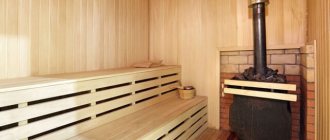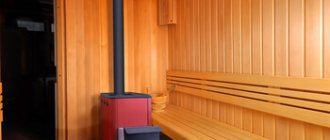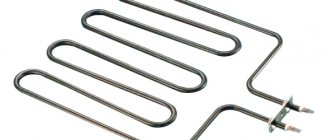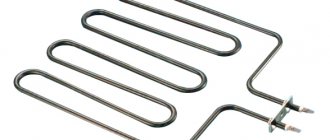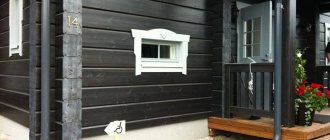- Design requirements
- Temperature/humidity ratio
- Steam quality: open or closed heater
- Furnace tunnel equipment
- Ease of maintenance and operation
- Advantages of electric heaters
- Advantages and design features
Do you like to take a steam bath and have you already prepared a place on your garden plot for a new building? Can you imagine how you will relax and improve your health after hard everyday life? Do you already know which stove is better to choose, for example, for a Russian bath and how to do it? We want to talk about this in detail, because the importance of purchasing heating equipment correctly can hardly be overestimated.
How to make a choice
The nature of the functioning of the stove depends on its design and the characteristics of the bath itself.
Answers to the following questions will help you make the right choice:
- how often and intensively the sauna is planned to be used;
- how quickly it should be ready for procedures, or whether the quality of the steam is more important;
- What fuel are you planning to use?
The ovens differ from each other:
- by productivity;
- the type of fuel used;
- according to the material of manufacture;
- according to the operating principle;
- by design;
- by vaping method;
- design.
If you purchase a model that is not powerful enough, it simply will not be able to heat the room properly. If you take an overly bulky design, it will be inconvenient to use and will take up too much space.
By fuel type
Perhaps the main classification criterion is the method of generating heat. According to this principle, all heater stoves are divided into wood-burning and electric, as well as gas (although much less common).
- The most popular stoves for private use are wood stoves. Their design includes two compartments: a firebox (bottom) and a heater (top). The outside of the stove has either a metal casing or a stone lining. Wood is burned in the firebox, and the heat from its combustion is transferred to the stones and further (through convection and radiation) to the steam room and the objects and people in it.
- Electrical. They are easy to install, safe and autonomous.
- Gas. Due to their compactness, ease of use and the ability to adjust the microclimate in the steam room, they remain popular.
According to the material of manufacture
When installing sauna stoves, metal (an alloy of different composition) or stone, of both natural and artificial origin (the same brick), is used.
When choosing which stove to put in your sauna, be sure to look at what it is made of. Factory models are made of metal: the simplest ones are made of carbon steel, but these burn out quickly, within 4 years. Higher quality ones are made of stainless steel alloyed with chromium. The most durable material is cast iron. Combined versions are also available, in which the firebox is made of alloy and the body is made of stainless steel.
Depending on the type of material, sauna stoves come from:
- carbon steel with a wall thickness of 1.5-3.0 mm (the most economical option), as well as 6.0 mm; 8-12 mm;
- stainless steel with wall thickness 2 mm and 4 mm (steel AISI 430/439);
- boiler room;
- cast iron;
- brick and/or natural stone.
For a Russian bathhouse, the best option would be a brick stove, but it is difficult to find a true stove professional, and the cost of his work will be high. This requires expensive maintenance, although such a stove will last a long time.
The advantages of materials stem from physical characteristics. So, it will take up to 5 hours to warm up the stone, but it will cool down for a day. Metal gives heat to the room within 30-120 minutes (on average), but it also conducts heat quickly, so you will have to periodically add firewood/supply gas/turn on electricity into the firebox.
There is also such an important point as reliability. The same structural steel is often used, since it is relatively cheap, but it burns out and rusts quickly enough. Cast iron is much more durable, especially if you do not subject it to various “tests” such as mechanical stress or pouring water on it in a hot state.
Our production
Single wall chimneys
Double wall chimneys
Mounting elements
The power of a wood stove is a significant parameter
The technical characteristics of sauna stoves always indicate the volume of the room for which the power of a particular stove model is calculated. As a rule, the range indicated is from 6 to 12 cubic meters. or from 12 to 24 cubic meters. etc. However, in this case it is not enough to simply multiply the height, length and width of the steam room. The fact is that to determine the volume of the steam room when choosing the required furnace power, there are some nuances.
- If you plan to heat the stove in winter, then add 30% to the resulting volume. In this case, the volume will better match the suitable oven power.
- If the steam room has surfaces that do not have a thermal insulation coating (concrete, brick, glass, etc.), then when calculating for each square meter of surfaces made of similar materials, another 1.2 m3 of volume should be added. For example, the volume of a steam room is 10 m3. Inside there is a glass door 0.8 meters wide and 2 meters high. Calculations: 10+2x0.8x1.2 = 11.9. It follows that the stove should be selected for a room with a volume of 12 m3.
- If the walls are made of massive logs, then the calculated cubic capacity must be increased by 1.5 times.
And now, the main thing is that the stove is selected to suit the size of the steam room only! Many bathhouse attendants strive to heat the entire bathhouse with a stove and, accordingly, are based on the size of the entire bathhouse. We will talk about whether it is possible to heat an entire bathhouse with a stove in our next article.
The above calculation rules are suitable for most steam rooms, where the interior decoration is made of clapboard with thermal insulation underneath. If you have some large panels made of salt, for example, or the decor takes up a lot of space, or the insulation is made of stone, then an individual calculation is required.
Principle of operation
Depends on the type of equipment selected. In gas models, fuel (most often propane), with a controlled supply, is mixed with air in the required proportions and releases heat during combustion. Thanks to this, the stone base quickly accumulates, and water poured onto it turns into steam.
In electric ones, heating elements located in the inner casing heat up the stones (with which they are lined). The latter, in turn, give energy to the air entering and exiting through special ventilation ducts. As a result, the room temperature gradually increases.
In wood-burning stoves, the fuel burns and gives off the generated heat to the heater or mesh casing. Due to this interaction, particularly soft vaporization is observed.
Design requirements
All sauna stoves have two compartments in their structure: a firebox (bottom) and a heater (top). On the outside, the unit has either a metal casing (if it is not made of brick) or a stone cladding.
For modern and simply better sauna stoves they are as follows:
- manufactured from materials that can stably withstand heavy loads;
- general safety of the device, reducing the likelihood of fire, poisoning and other risks;
- balance between heating speed, cooling speed and humidity provision;
- efficiency in terms of fuel consumption;
- convenient sizes for use.
The best stove for a bath with a heat exchanger
Ermak 12 belongs to the economy class line, but this does not indicate poor quality. Material – stainless steel with chromium content. It is resistant to corrosion. The oven has standard dimensions for its class: 425×520×690 mm. Weight – 52 kg.
The weight of the laid stones is 40 kg. This indicator requires longer heating of the raw materials. A remote tank and heat exchanger are included in the package.
Characteristics:
- Power – 12 kW.
- Working area – 14 m3.
- Zone for stones - 40 kg.
- Firewood length – up to 450 mm.
Pros:
- Rich equipment.
- Moderate microclimate. The water in the stove is hot, but does not boil.
- Price. Low price.
Minuses:
- The stones heat up slowly.
Vaping method: selection according to parameters
Start with the simplest thing - think about who will take a steam bath and how often, or maybe even just wash. For professional use (when providing paid services) you will need one heating equipment, for constant relaxation among amateurs - another, for simple family gatherings on occasion - a third, for undemanding beginners - a fourth.
It’s also worth deciding what type of steam room to make. If it is Russian, then she needs a closed heater, made of brick or metal, but with a stone lining, and so that its vents are closed. Then it will be possible to easily control convection, that is, regulate heated air flows. If it is a Finnish sauna, then, as a rule, it is a steel stove with convection casings for heating the steam room as quickly as possible. Moreover, to soften hard radiation, such furnaces are lined with stone or a mesh casing.
Temperature/humidity ratio
In other words, microclimate. One piece of equipment can create real heat in a matter of minutes, but at the same time dry out the air. Another is to provide a soft and even gentle atmosphere, but not warm the room properly.
A stove for a Russian bath should produce up to 60°C at 55-60% humidity, a Finnish sauna requires 90°C and 15%, and a Turkish hammam requires up to 45°C and up to 100%, respectively.
Based on this, the area of infrared radiation when heating a material becomes especially important: the larger it is, the drier the air, and vice versa.
No. 6. Steam source
Sauna stoves can be conventional or with a steam generator . What is the last one for? And in order to provide the room with a sufficient amount of steam when the stove itself cannot cope. The first sign of a real Russian bath is dry and light steam. Not all modern ovens are capable of producing it in sufficient quantities.
Light steam is obtained at a temperature in the steam room of 850C. In this case, finely dispersed steam is obtained when water hits stones heated to 5000C. With such heating, the air temperature certainly rises, to incredible limits, and as a result, you can get a burn. To prevent this from happening, they created ovens with a steam generator . It warms up much faster than the stones and saturates the steam room with the necessary steam, while the air temperature in it remains optimal.
Heater type
Open - there is contact of stones with the external environment, either their upper layer, or all that are covered with a mesh casing. It quickly raises the temperature in the rooms to the required level, but also cools down very quickly. Suitable for those steam rooms that are frequently visited and therefore the heating unit is turned on almost continuously.
Closed - contact is almost eliminated due to its location directly in the firebox. The energy generated as a result of the combustion process heats the stones to the desired temperature, which makes it possible to obtain “light” steam. This oven cools down slowly, which allows you to use the steam room the next day.
Steam quality: open or closed heater
The convective component is responsible for the rate of heating of the air in the room. The better the convection process in the structure is established, the sooner the steam room is brought to the desired temperature value.
But microclimate is determined not only by temperature. Contact causes mainly superficial heating of the skin. The radiant component of stove heat is largely responsible for the deep heating of tissues and organs and the healing effect on the human body. The more capacious the stove is equipped with, the milder the climate it can create, the more opportunities it has for generating radiant heat and producing high-quality steam.
There are furnaces in the design of which there is practically no convective component, and the radiant component is, accordingly, the main one. It is precisely these models that are most suitable for creating a regime close to the traditional Russian bathhouse. Models that create a mild and humid climate are distinguished by a large mass of stones, and therefore, for the most part, a long preparation period for a soaring session. The raw material heats up and cools down much longer than air. Systems that have a large mass in their design are capable of prolonged heat radiation, but they take a relatively long time to heat up.
Light steam of optimal condition can only be obtained from beams heated to a temperature of 350-400°C or higher. Such heating can only be achieved in a confined space, namely in a closed heater. The stones, completely contained in an iron container, are heated from almost all sides. This is how you can get finely dispersed and high-temperature steam that will not burn.
The situation is different with an open heater. As a rule, metal stoves with it are used for saunas and dry-air steam rooms. In these types of top of the stove system, the stones are on the outside, and in this case they cannot be heated to high temperatures. But if this is done, the temperature in the steam room will become very high and uncomfortable. At normal temperature conditions, the steam room heats up to 200-250°C. The result will be heavy, wet steam, which will burn the body and lungs.
If you need quick heating of the bath in a short time, then convection models are suitable for you. This option is also suitable for saunas and dry-air steam rooms. The downside is their rapid cooling and the presence of hot surfaces. The solution for a Russian steam room is to use a cast iron model, then cooling will be slower.
To obtain light steam, it is recommended to line metal stoves with stone or brick: this will reduce hard infrared radiation from the metal surface. Stone or brick gently transfers heat to the steam room without overheating it and maintaining a stable temperature for a long time. Such heat does not burn, but, on the contrary, penetrates deeply, warming the body without harming it.
It is necessary that the steam is light, that is, of a fine structure, with a low proportion of humidity. Then it will not change blood pressure and will help you tolerate high fever. But to get it, you need to heat the working surface to 350-500 °C, and this cannot be done directly in the steam room, since the room will be too hot.
If you purchased a stove with an open heater, but you need a Russian bath, the solution to the problem can be to equip it with a special device - a steam generator (gun) located on the side, which produces light and transparent, that is, high-quality steam.
The main advantages and disadvantages of stoves with a closed heater and a steam generator
Stoves with a closed heater have the following advantages:
- from the point of view of generating heat and steam, this is a more classic heating method;
- a larger stack, as a result, a higher mass of coolant;
- long cooling.
But there are also weaknesses:
- Dust forms on the stones, so they need to be washed once every 2 years.
- A large weight puts pressure on the walls, which leads to deformation of the firebox.
- The heater itself is deformed under the weight (an exception in this regard may be cylindrical versions).
Advantages of models with a steam generator:
- absolutely clean steam (no dust);
- fast heating.
Disadvantages include:
- fast cooling.
Classification by fuel type
Depending on your region of residence and access to a particular fuel, you can choose a sauna stove that will show the optimal cost of operation. At the same time, some models will force you to put up with some features of their use. Others will offer the maximum level of convenience and comfort.
Wood burning
Firewood is the most accessible and inexpensive type of fuel in most regions of the world. It is thanks to its prevalence that there are a huge number of models of heating devices on the market. Wood-burning sauna stoves come with closed and open heaters and are equipped with a flue gas afterburning system. They heat up quickly and offer a natural smoky flavor.
A wood-burning stove is ideal in places where there is no centralized gas supply or the ability to inexpensively purchase liquid fuel. However, it will force you to adapt.
- Firewood supplies need to be stored somewhere.
- Control of combustion intensity and fire safety rests entirely with the owner.
- The third negative factor lies in the service. You need to remove the ash yourself and periodically clean the chimney. And finally, fuel will have to be constantly added.
If such difficulties do not frighten you, wood stoves will provide their owner with:
- reasonable cost of purchasing fuel;
- excellent level of heat transfer;
- the opportunity to choose one of the many models on the market.
On a note! You can build a wood stove with your own hands. And if you use some inventions, for example, equip the unit with a water supply unit for its splitting and participation in combustion processes, it is easy to obtain a device that works for a long time on one portion of fuel.
Gas
Gas furnaces are equipped with a burner system and automatic controls. They definitely have security measures in place. Thus, equipped with automatic ignition and automatic shutdown of fuel supply in the absence of flame, gas sauna stoves become very safe installations.
The disadvantage of the unit is precisely its source of thermal energy. A gas stove must either be connected to a centralized supply system, or sacrifice safety by connecting a liquefied fuel cylinder to it. However, after solving one of these problems, the heater will provide very comfortable operating conditions.
- The heat output is very large, the steam room warms up quickly.
- Fuel consumption is low.
- Gas sauna stoves are compact and lightweight.
- You can buy a closed or open type system.
- The chimney and fuel chamber require virtually no maintenance.
- You can set the operating mode once and enjoy the comfortable atmosphere in the steam room.
Important! Gas furnaces are extremely unpretentious devices. You don't need to pay attention to them. Equipped with automatic control, they simply turn on and work without owner intervention.
Liquid
Liquid fuel stoves belong to the category of less common devices, the reason is the high cost of fuel . However, if there is no other alternative, it is worth purchasing just such a model. Today, the industry produces units that run on gasoline and diesel fuel. According to the principle of operation, they are similar to gas installations; they have nozzles and a control system.
However, in terms of maintenance requirements, a liquid stove will require you to do almost the same operations as a wood stove. The combustion chamber and chimney must be cleaned and the amount of available fuel monitored. But at the same time, liquid fuel stoves offer comfort at the level of gas equipment.
There are also homemade solutions. Sauna stoves that run on waste machine oil or low-quality diesel fuel are extremely simple devices. If desired, everyone can find drawings of installations for self-assembly on thematic forums or websites.
Electrical
Electric ovens are simple in design and easy to understand in their operating principle. They install several heating elements of high total power. The stove warms up in minutes and quickly creates a comfortable atmosphere in the bathhouse. Most electric stoves come with an open heater. Units of this type do not burn fuel, so they do not need a chimney. The overall installation can be very easy and compact. Most of its mass is always made up of cobblestones.
The electric oven is safe, quickly installed, and repairable . The lack of need for a chimney has led to widespread demand for it from apartment owners. With the help of an electric stove, it is easy to turn a bathroom into a sauna or allocate a dressing room for this purpose.
Important! The only disadvantage of units of this type is the wiring requirements. Before connecting an electric oven, you should make sure that there is no overload with all the ensuing negative consequences.
Hybrid
By the name of the type of furnace, you can understand that they are capable of using several types of fuel. This is convenient if gas, wood, and coal are available in certain seasons. The use of two types of fuel allows you not to make significant reserves and consume the most preferred source of thermal energy.
Gas-fired sauna stoves are equipped with a system of removable blocks. You can install a container for firewood, with a grate, a blower door and an ash pan, or use a burner block with automatic control for burning gas. Today, most models are focused specifically on solid fuel. Gas equipment is offered as an option.
Combination stoves, depending on the fuel burned, have advantages and disadvantages of the corresponding types of units. When using firewood, you will have to monitor the installation, clean the firebox and chimney. And gas burners will offer all the convenience of self-regulated equipment that does not require the attention of the owner.
Main selection criteria
There are a variety of sauna stoves on the market, which ones are best? Their different types and designs are worth comparing based on key parameters, each of which we will now consider in detail.
Furnace tunnel equipment
It is useful for three reasons:
- takes oxygen from adjacent rooms and supplies it to the steam room;
- protects against excess dirt (for example, soot from firewood);
- makes it possible to admire the play of a living flame (if equipped with a heat-resistant glass door).
Availability of a convector
Don’t forget about it when you’re thinking about how to choose the right stove for a sauna, because with it, air masses constantly move around the room and due to this, all rooms are heated evenly. If it is installed, there will definitely not be a situation where your head is hot and your feet are cool, so it will not be superfluous.
All sauna stoves have convective and radiant types of heat transfer. Heating from the walls of the firebox, hot air rises, and cold air enters from below to replace it. Thanks to the described circulation, the heated one gradually fills the entire steam room. To accelerate convection, special channels are provided in the design.
In wood-burning stoves, the role of a convection channel is played by the air gap between the walls of the firebox and the outer casing. The steam, heated by the hot walls of the firebox, rises up and enters the steam room through special holes in the upper part of the casing.
No. 7. Cold and hot ovens
Depending on how hot the walls are, ovens can be:
- hot , the surface heats up to 1000C, so the steam room quickly becomes warm. Such stoves are great if there is no constant heating in the bathhouse. The downside is the inability to control the temperature in the steam room, to the point that the air can become very hot;
- walls cold ovens they heat up to 45-500C, cold air is taken in through special channels, and it returns in a heated state. The thermal regime is stable, humidity and temperature can be adjusted. It will take a long time for the steam room to warm up, but if you are not in a hurry, you will appreciate all the advantages of these stoves.
Additional selection criteria
There are two more parameters that are not paramount, but are also important when choosing a stove:
Ease of maintenance and operation
Be sure to look at how convenient it is to supply/load fuel into the selected model and remove residual combustion products from it.
Design and dimensions
As you know, the greater the mass of the coolant (which is often achieved by a spacious heater), the longer it retains heat. Therefore, if you choose the Russian steam room option, you need to calculate its area and foundation in advance (in the case of cast iron and brick options).
As for the external design, now on the market you can find a wide variety of stove shapes, in height and width, with or without a mesh for stones, as well as various lining options.
Stones
When choosing stones, follow the following rules:
- The breed is resistant to high temperatures and changes.
When used in a bathhouse, stones endure a heavy load: first they are heated to maximum temperature, then they are poured with water, which leads to uneven cooling. Not every breed is able to withstand this without losing its original appearance. The higher the heat resistance, the less likely it is to crack and chip. You can check the density yourself: by tapping the surface with a hammer or by placing it in cold water after heating it. If in both cases it has retained its integrity, you have a quality copy in your hands. The appearance of cracks indicates low heat resistance.
- Ability to retain heat for a long time.
Fast heating and long-term heat transfer are the main requirements of bathhouse attendants for stones. As a rule, they are distinguished by their large mass and homogeneous structure. High density and homogeneity of the rock is half the success in a steam room, since it quickly warms up and cools down for a long time, giving off heat; resistant to temperature changes.
- Dimensions.
When selecting the necessary species, do not forget that for each type of stove certain sizes are preferable. Stones should be selected based not on aesthetic principles, but on practical ones. Large stones from 7 to 15 cm are ideal for wood-burning stoves, but for electric stoves the best option is small stones from 5 to 7 cm.
It is not necessary to fill the heater with stones of the same type; more intense and useful steam can be achieved by mixing representatives of different properties. It is recommended to fill the lower level with pebbles, crimson quartz, and basalt. Peridotite and soapstone are perfect for the upper part. How to properly arrange the rocks in the heater?
Water heating tank
It is required for two reasons:
- so that you have something to wash yourself with while taking a warm shower;
- to raise the humidity level in the steam room and maintain it at the desired level.
It can be built-in (combined with a heater and firebox), mounted, connected to a heat exchanger or directly to the chimney, but in any form it increases efficiency, so its installation will definitely not be superfluous. The modern version is presented in the catalogue.
Video description
This video shows 7 important rules for choosing sauna stoves:
Hephaestus PB-04
This model is made of cast iron. To operate the stove, it must be mounted inside a brick insert. The combustion channel of this model is elongated, which allows it to be moved into a separate room adjacent to the firebox. An important feature of the stove is the wall thickness of 1-6 cm, eliminating the possibility of burnout. The parts of the device are made of cast iron with a high chromium content.
The device is equipped with: an afterburning system and a flame arrester, which promote more complete and prolonged combustion of fuel.
The features of this oven are as follows:
- Wall mounting is used.
- The furnace power is 8 kW.
- Designed to heat a room with a volume of 15 cubic meters. m.
- An open type heater is used, which can hold 180 kg of stones.
- The cast iron from which the stove is made heats up quickly and releases heat slowly. The efficiency of the device is 87%. The door is decorated with gilding and ornaments. The weight of the fully assembled structure is 700 kg.
Features of choosing electrical options
It is necessary to give preference to a model of a modern design, that is, with two reliable housings, and such that the outer one cools the inner one, in which the heating element will be located. And it needs to be placed in the corner of the steam room, and it should be installed on a ceramic base and with a protective fence - to prevent injuries that can be caused by accidentally touching a hot surface.
Advantages of electric heaters
When choosing an electric oven, focus on the following parameters:
- good heating rate with a high degree of safety;
- the ability to flexibly adjust the temperature and the presence of other additional functions;
- ease of maintenance and operation;
- Possibility of use in an apartment.
The disadvantages include the following:
- high cost of electricity;
- use only in sauna and dry-air steam room mode.
There is an opinion that during operation such equipment produces electromagnetic radiation. But so far no one has provided convincing evidence of the validity of this point of view. And in any case, the heat generator does not produce a frequency above 50 Hz, at which the generated field could be harmful to health, so you can calm down.
The best stove for a long-burning sauna
Tulinka NVU-150 has a non-standard design - in the form of an iron barrel on legs. It is capable of heating air with a volume of 150 m3. Works on wood, cardboard. Coal will not work.
The firebox is the inner cylinder, the outer one is used as a convector casing. Cold air is sucked in by two holes at the bottom. It comes out hot through the top ten holes.
The temperature is regulated by two dampers. One of them is intended for supplying air to the firebox, the other for chimneys. Smoldering wood contributes to 8-hour heating of the bathhouse with the dampers closed.
When they are open, the wood burns, that is, the room quickly warms up (10-15 minutes).
Characteristics:
- Manufacturer – Russia.
- Material – steel.
- Power – 8.4 kW.
- Weight – 48 kg.
- Service life – 20 years.
Pros:
- Quick heating of the room.
- Large working area.
- Versatility. Suitable for country houses, cities.
Minuses:
- Design. Simplicity and rough lines of the body.
Features of choosing a gas oven
To install it, you need to obtain special permission. A good model is quite expensive, so this type is relatively rarely preferred today. And in vain, because in the long run it pays for itself many times over.
Advantages and design features
The body is equipped with a gas burner, above it there is a pipe for removing combustion products and a tray with stones. Usually there is a thermostat and a fuse that stops the fuel supply when the flame disappears; an additional water heating tank can be added (or even included in the kit).
The gas model has the following advantages:
- the temperature is adjusted automatically;
- the steam room heats up evenly and in a short time;
- there is no need to periodically load fuel - it is supplied without your participation as it is consumed;
- Maintenance is as simple as possible - in particular, there is no need to empty the ash pan.
And this is with constant gas availability and comparative safety of the design.
Installation requirements for gas models
- Such equipment must be placed on a flat and solid base, separated from the foundation - for stability.
- The walls must be protected from thermal effects by separating the heating unit with insulating material (graphite fiber or asbestos).
- If gas will be taken from a common line, it should be connected to it using a reliable hose. If from a cylinder, then it is important to protect it from temperature influences, for example, place it outside the steam room.
- It is also necessary to organize ventilation, place additional devices and accessories (such as a water tank) and integrate a control system.
The best sauna stove with a water tank
Termofor Kalina Carbon is easy to use, compact and not inferior to premium options in terms of capabilities and build quality.
It has a logical and convenient arrangement of controls, all parts fit tightly together, the body is black with a matte texture made of structural steel - a material resistant to corrosion and scratches.
Panoramic glass for relaxation, internal loading of stones up to 95 kg using a pull-out compartment for long-term heat retention.
A chimney labyrinth to increase the efficiency of the stove and a built-in heat exchanger for heating water in the tank.
Characteristics:
- Volume – 30 m3.
- Power – 15 kW.
- Weight – 96 kg.
Pros:
- High power. Heats a large sauna area.
- Built-in heat exchanger. To improve microclimate indicators.
Minuses:
- Restrictions. Not suitable for a small bath, only for a large one due to its dimensions.
- Economical material. Loses to models made of steel and chrome.
How to choose a gas stove for a sauna: key recommendations
- Focus on performance first. The equipment must fully service the area of the steam room and adjacent rooms. So take a look at the data sheet (usually the already mentioned 10 kW of power is enough).
- Pay attention to where the water heating tank is installed (if there is one at all). The best option is its location on the pipe, because it is more practical (and maximum efficiency), and ease of use also increases.
- Look at what gas the model you are interested in can run on: natural, liquefied or both. If the system is a combination system, make sure it has removable nozzles.
- Take a look at whether the kit includes a control device, and if so, what is it? If it is not there, you will have to purchase it separately.
Watch an educational video about how a gas burner works for a horn-type brick model:
No. 10. Furnace shape
The shape is the last thing people pay attention to, and then they consider it more from the point of view of dimensions. It is worth noting that classic rectangular ovens are a priority. They are more stable and heat up evenly, which cannot be said about cylindrical models , the upper and lower parts of which are heated differently.
Which stove to choose for a bath: consider the technical characteristics
Each model can be classified according to the following parameters:
- Thermal power - it should be enough to completely heat all rooms (not just the steam room) in 1.5-2 hours in winter and 40 minutes in summer. The average for most popular units is usually 10 kW.
- If the bathhouse is made of logs, then it is necessary to make calculations with a power reserve.
- The capacity of the storage device must provide transparent, and not damp and/or heavy steam with a temperature consistently above 100°C. In most cases, 100g/m3 is enough for normal operation of equipment.
- The type of fuel used is electricity, wood or gas. The main thing is that the chosen option is not only economical and energy efficient, but also safe.
- Duration of operation - it is important that the selected stove retains heat well and can operate continuously for 3-4 hours (or even longer).
- The material of manufacture is carbon, boiler or stainless steel, as well as cast iron. Typically, preference is given to a metal that produces minimal oxygen combustion.
- Type of heater - if it is open, the air is heated by hot stones, and the room is heated relatively quickly, if it is closed, heating occurs through the walls, from the firebox, that is, somewhat slower.
- Heat exchanger – its presence in practice reduces fuel consumption (while stably maintaining the desired temperature).
What else should you pay attention to when buying a sauna stove:
- Seam welding quality.
- The shape of the firebox bottom. The ideal option is to have bevels so that the coal formed after burning wood does not contribute to the burning of the walls. If, when examining the internal structure (through the pipe), you see even just a little bit of the bottom or grate, there is a possibility of fire entering the chimney, and as a result, its premature failure.
- Options for fastening doors with glass. If the glass is framed, the likelihood of it cracking is very low.
The best stove for a sauna with a closed heater
Vesuvius Skif is made of gray steel with a matte surface. The door has many forged decorated elements in a golden hue. The built-in heater, heating up to 400˚C, allows you to get “light” steam.
To “plug” the convection part, the oven is equipped with a grate.
The element holds stones along the entire perimeter of the body. Proper air circulation allows you to heat the room in 1 hour. Characteristics:
- Power – 15 kW.
- Volume – 24 m3.
- Weight – 91 kg.
Pros:
- Large heated area.
- "Light" steam. It will be comfortable in the bathhouse.
- Safety.
Minuses:
- Large mass. Quite a heavy model.
Buying a sauna stove - which one to choose and what does the price say?
Attention, a solid price does not always indicate excellent quality. The amount may be overestimated due to the popularity of the manufacturer or due to the fact that the model has just entered the market and is a new product, a fresh hit of the season.
But the low price tag should immediately alert you. Usually it is a characteristic feature:
- made from not the highest quality material;
- too thin walls of the body/firebox;
- minimum configuration;
- execution using obsolete technology.
So you shouldn’t blindly chase after cheapness - excessive savings may result in the need to prematurely replace heating equipment.
We tried to comprehensively review sauna stoves; the review includes all the important parameters of their choice - decide, buy, install, use and enjoy your health.
Briefly about the main thing
It is difficult to say which stove is better for a bath - wood-burning or electric, brick or cast-iron. Everyone has their own preferences, and one bathhouse is not like another.
If we talk about solid fuel units, which are the most in demand, then their choice is based on several criteria. This is the power required for high-quality heating, the material of manufacture, the presence of a tank necessary for preparing hot water for washing.
The most important design feature is the location of the combustion chamber, which can be built-in or remote, allowing you to heat the bath not from the steam room, but from the dressing room.
True lovers of bathing procedures should pay attention to the type and volume of the heater, on which the quality of the steam depends.
A huge range of sauna stoves produced in our country and abroad allows you to find equipment that meets any requirements.
Ratings 0


